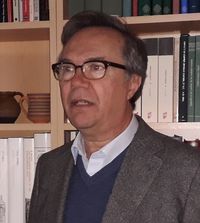
Juan Manuel Abascal Palazón (*1958)
Juan Manuel Abascal Palazón teaches ancient history at the University of Alicante. He was, among others, responsible for the new edition of CIL II2/14,4 on Tarraco and for editing the inscriptions from the conventus Carthaginensis.
Further information.
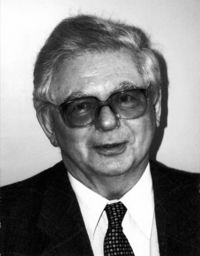
Géza Alföldy (1935–2011)
Géza Alföldy was professor of ancient history at the University of Heidelberg from 1975 to 2002. Between 1994 and 2007, Alföldy was project director and thus responsible for the CIL’s scientific orientation. He has edited CIL volumes on Spain and the city of Rome.
Further information.

Rafael Atencia Páez
Rafael Atencia Páez teaches at the University of Málaga. Alongisde others, he was involved in editing the inscriptions from the conventus Astigitanus in CIL II²/5.
Further information.
Johann Martin Bang (1882–1956)
Johann Martin Bang contributed to editing the inscriptions from the city of Rome and compiled the Nomina index to the same volume. He had been working on a manuscript of the supplement to CIL VI, which was lost in the Second World War.
Oscar Bohn (1853–1927)
Oscar Bohn edited the instrumentum domesticum of the Gaulish and German provinces in CIL XIII 3,1 and CIL XIII 3,2.
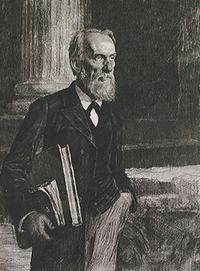
Eugen Bormann (1842–1917)
Eugen Bormann taught ancient history at the Universities of Marburg and Vienna. He was coauthor of several CIL volumes on the city of Rome and edited the inscriptions from Emilia-Romagna, Etruria, and Umbria (CIL XI).
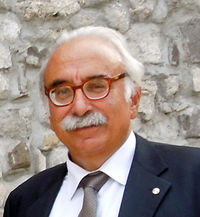
Marco Buonocore (1954–2022)
Marco Buonocore was Scriptor Latinus and director of the archive of the Biblioteca Apostolica Vaticana. He is responsible for the supplementary volumes on regio IV in CIL IX (Inscriptiones Calabriae Apuliae Samnii Sabinorum Piceni latinae).
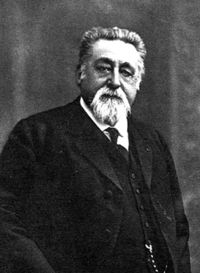
René Cagnat (1852–1937)
René Cagnat was professor at the Collège de France. In collaboration with Johannes Schmidt and, later, with Hermann Dessau, he edited the supplementary volumes on the North African inscriptions.
Further information.

Camilla Campedelli (*1979)
Camilla Campedelli is a research associate at the CIL. She edited the milestones of Hispania citerior (CIL XVII/1,1) in collaboration with Manfred Schmidt.
Further information.
Pio Ciprotti (1914–1993)
Pio Ciprotti, alongside Matteo della Corte, compiled the inscriptions from the Vesuvian cities in CIL IV Suppl. 3.
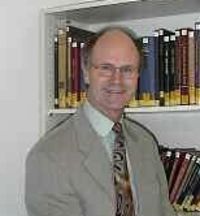
Manfred Clauss (1945–2025)
Manfred Clauss taught ancient history at the Universities of Siegen, Eichstätt, and Frankfurt. He initiated the Epigraphic Database Clauss Slaby, which is the most extensive database for Latin epigraphy. Clauss contributed to the edition of the inscriptions from the conventus Tarraconensis in CIL II²/14,1.
Further information.
Matteo della Corte (1875–1962)
Matteo della Corte held different positions as archaeologist in Pompei. Alongside Pio Ciprotti, he compiled the inscriptions from the Vesuvian cities in CIL IV Suppl. 3.
Further information.

Attilio Degrassi (1887–1969)
Attilio Degrassi taught ancient history and Latin epigraphy at the Universities of Palermo, Padua, and Rome (La Sapienza). He edited several volumes on the Inscriptiones Italiae as well as both volumes on the Inscriptiones Latinae liberae rei publicae. His addenda to the Republican inscriptions were published posthumously as CIL I2 2,4.
Further information.
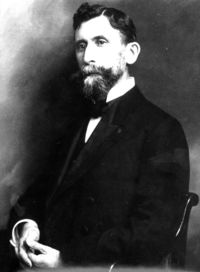
Hermann Dessau (1856–1931)
Hermann Dessau was the first scientific official of the Prussian Academy and worked for the CIL from 1900 to 1922. On his research trips, he visited Italy and North Africa. Dessau held lectures in Berlin. He compiled the Inscriptiones Latinae selectae and edited, among other, the Prosopographia Imperii Romani. Hermann Dessau authored more than 600 articles in Paulys Realencyclopädie der classischen Altertumswissenschaft and published several volumes for the CIL.
Further information.

Alfred von Domaszewski (1856–1927)
Alfred von Domaszewski held the newly established chair of ancient history at the University of Heidelberg between 1887 and 1924. He contributed to the supplement to CIL III and to the edition of the milestones from Gaul and Germania for CIL XIII.
Further information.
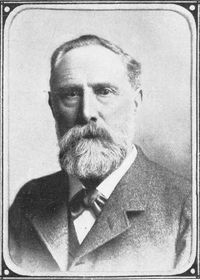
Heinrich Dressel (1845–1920)
Heinrich Dressel travelled through Italy for the CIL between 1874 and 1878 and collected material for CIL IX and X. From 1878 onwards, he stayed in Rome, was concerned with the instrumentum domesticum, and edited CIL XV.
Further information.
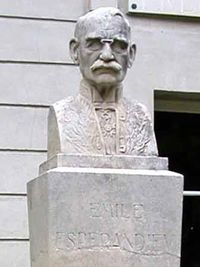
Émile Espérandieu (1857–1939)
Émile Espérandieu initially pursued a military career before he started working on Latin inscriptions and sculptures, particularly from Gaul. Espérandieu created the Recueil général des bas-reliefs de la Gaule romaine and the Inscriptions latines de Gaule narbonnaise (ILGN). For the CIL, he edited the ophthalmologists’ stamps from the Gaulish and German provinces in CIL XIII 3,2.
Further information.
Hermann Finke (1877–1947)
Hermann Finke held different (leading) positions in the library and archive of the Ruprecht Karl University of Heidelberg from 1900 onwards. In 1934, he began to give lectures on epigraphy and numismatics there. Alongside Otto Hirschfeld, Finke was responsible for the addenda to the first and second part (Aquitania, Lugdunensis, Belgica) of CIL XIII.
Further information.

Julián González Fernández
Julián González Fernández taught Greek and Roman philology at the University of Sevilla. He compiled the first two volumes of the corpus of Latin inscriptions from Andalusia. He took part in publishing CIL II2/5.
Cristóbal González Román
Cristóbal González Román teaches ancient history at the University of Granada. He is amongst the editors of CIL II2/5.
Arthur Ernest Gordon (1902–1989)
Arthur Ernest Gordon taught classical philology at the Universities of Vermont at Burlington and California at Berkeley. He laid the groundwork for the Grammatica index to CIL VI, which was published after his death by Hans Krummrey and Ulrike Jansen.
Further information.
Luise Hallof
Luise Hallof contributed the index to CIL VI 7,7.
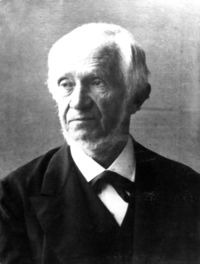
Wilhelm Henzen (1816–1887)
Wilhelm Henzen became second secretary of the German Archaeological Institute in Rome in 1843 and first secretary in 1856. Alongside Theodor Mommsen and Giovanni Battista de Rossi, he was main publisher and ‘director’ of the CIL. In collaboration with Giovanni Battista de Rossi, he edited the inscriptions from the city of Rome. Henzen published the fasti consulares as well as the fasti triumphales.
Further information.
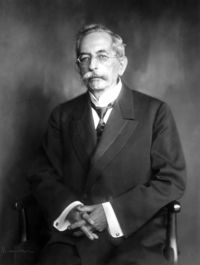
Otto Hirschfeld (1843–1922)
Otto Hirschfeld taught Classics at the Universities of Prague and Vienna, and, from 1885, as the successor of Theodor Mommsen, at the Friedrich Wilhelm University in Berlin. Hirschfeld edited several CIL volumes, especially from the Gaulish and German regions (CIL XII and XIII), which were the focus of his research. Hirschfeld was member of the Prussian Academy and thus took charge of the CIL after Mommsen’s death.
Further information.
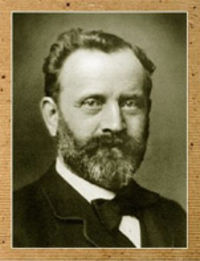
Emil Hübner (1834–1901)
Emil Hübner taught classical philology at the Friedrich Wilhelm University in Berlin from 1863. In 1869, he edited the inscriptions from the Iberian Peninsula for CIL II, as well as a supplementary volume in 1892. In 1873, Hübner’s edition of the Latin inscriptions from Britannia was published in CIL VII; the Exempla scripturae epigraphicae Latinae in the Auctarium to the CIL followed in 1885.
Further information.
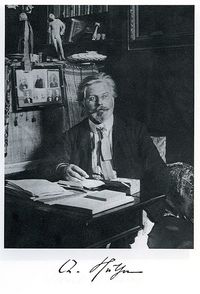
Christian Hülsen (1858–1935)
Christian Hülsen was second secretary of the Archaeological Institute of the German Empire in Rome from 1887 to 1909. Hülsen became a corresponding member of the Prussian Academy of Sciences in 1907, and of the Bavarian Academy in 1912. From 1918 he was an extraordinary member of the Heidelberg Academy, and from 1933 an external member. At the University of Heidelberg he was honorary professor since 1917. For the CIL, Hülsen worked on the inscriptions of the city of Rome.
Further finden Sie weiterführende Informationen.
Ulrike Jansen (*1963)
Ulrike Jansen is research associate at the CIL. In collaboration with Hans Krummrey, she completed the Grammatica index to CIL VI, which was begun by Arthur Ernest Gordon. Jansen also contributed to the edition of milestones from Raetia, Noricum, and Dalmatia.
Further information.
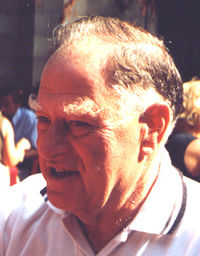
Edward John Jory (1936–2016)
Edward John Jory compiled the Key Word in Context index to the inscriptions from the city of Rome in CIL VI 7,1–6 in collaboration with D. W. Moore at the University of Western Australia in Perth.
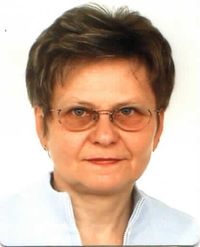
Jana Kepartová (*1959)
Jana Kepartová teaches Classics at Charles University in Prague. She contributed to the edition of the first volume of CIL IV suppl. 4.

Anne Kolb (*1964)
Anne Kolb is professor of ancient history at the University of Zurich. She contributed to the edition of the emperors’ inscriptions from Rome in CIL VI 8,2. Anne Kolb is responsible for the publication of the milestones in CIL XVII.
Further information.
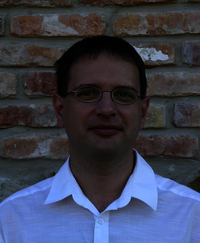
Péter Kovács (*1969)
Péter Kovács teaches history at Péter Pázmány Catholic University in Piliscsaba. Together with Barnabás Lőrincz, he is responsible for editing the milestones from Pannonia in volume CIL XVII/4,3.
Further Information.

Hans Krummrey (1930–2018)
Hans Krummrey was managing director of the CIL Research Centre in Berlin between 1967 and 1995. He published CIL I2 2,4 as well as the index to the Republican inscriptions. Alongside Ulrike Jansen, he completed the Grammatica index to CIL VI, which was begun by Arthur Ernest Gordon.
Further information.

Peter Kruschwitz (*1973)
Peter Kruschwitz teaches ancient cultural history at the University of Vienna. Between 1997 and 2007, he was employed at the CIL and contributed to the edition of the officials’ inscriptions from Rome in CIL VI 8,3. He is among the authors of the supplement to the wall paintings from the Vesuvian cities and involved in editing the Carmina Latina Epigraphica.
Further information.

Ursula Lehmann (1922–2014)
Ursula Lehmann was staff member at the CIL Research Centre in Berlin and involved in editing CIL VI 7,7.
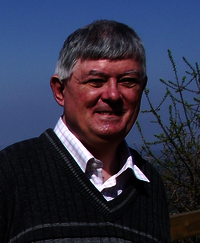
Barnabás Lőrincz (1951–2012)
Barnabás Lőrincz was employed as an archaeologist and museologist at the Intercisa Museum in Dunaújváros from 1974 to 1984. From 1984 onwards, he held various positions at the Institute of Ancient History at Eötvös Loránd University, where he also obtained his habilitation in 2004. Together with Péter Kovács, he is responsible for the edition of the milestones from Pannonia in volume CIL XVII/4,3.
Further Information.
Ernst Lommatzsch (1871–1949)
Ernst Lommatzsch was general editor of the Thesaurus Linguae Latinae between 1905 and 1912 and taught classical philology at several German universities. He edited the inscriptions from the Roman Republic in CIL I2 2,1–3.
Further information.
Roberta Marchionni (*1965)
Roberta Marchionni worked for the CIL between 2002 and 2012 and contributed to the edition of the first volume of CIL IV Suppl. 4. She has been employed at the Thesaurus Linguae Latinae since 2013.
Further information.

August Mau (1840–1909)
August Mau was secretary at the German Archaeological Institute in Rome from 1873. Inscriptions and mural paintings from Pompei were the focus of his research. He edited CIL IV Suppl. 2.
Further information.
Marc Mayer Olivé (*1947)
Marc Mayer Olivé taught classical philology with a focus on Latin epigraphy at the Universities of Murcia, Alicante, and Barcelona. He contributed to the edition of the inscriptions from the conventus Tarraconensis in CIL II²/14,1.
Further information.
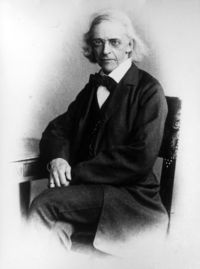
Theodor Mommsen (1817–1903)
The CIL was founded in 1853 on the initiative of Theodor Mommsen as a project of the Prussian Academy of Sciences. He led the project until his death. He contributed to the volumes CIL I, III, V, VIII, IX, X, XIII, and XVI.
Further information.
Dennis William Moore (*1937)
Dennis William Moore compiled the Key Word in Context index to the inscriptions from the city of Rome in CIL VI 7,1–6 in collaboration with Edward John Jory at the University of Western Australia in Perth.
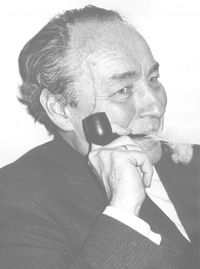
Herbert Nesselhauf (1909–1995)
Herbert Nesselhauf worked for the CIL and edited the volume on military diplomas in 1936. In 1955, the supplementary volume was published. From 1942, Nesselhauf taught ancient history at the Universities of Kiel, Freiburg, and Konstanz.
Further information.
Heike Niquet (*1969)
Heike Niquet was employed at the institute of ancient history and epigraphy of the University of Heidelberg. She contributed to a new edition of CIL II2/14,4 on Tarraco and edited the officials’ inscriptions from Rome in CIL VI 8,3.
Further information.

Silvio Panciera (1933–2016)
Silvio Panciera was professor of epigraphy and Classics at the University La Sapienza in Rome between 1963 and 2006. He actively promoted the Epigraphic Database Roma. Panciera primarily studied inscriptions from the city of Rome. In particular, he was responsible for the collection of sacred inscriptions, of which CIL VI 8,1 libellus 1 has been published.
Further information.

Mauricio Pastor Muñoz (*1948)
Mauricio Pastor Muñoz teaches ancient history, previously at the University of Salamanca, now in Granada. He published a corpus of the Latin inscriptions from Granada and contributed to the volume CIL II2/5.
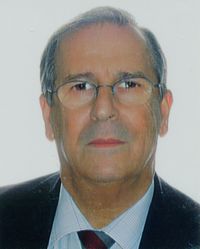
Pedro Rodríguez Oliva (*1947)
Pedro Rodríguez Oliva teaches archaeology at the University of Malaga.
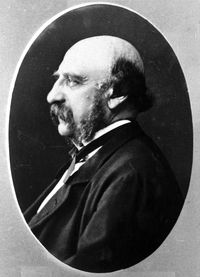
Giovanni Battista de Rossi (1822–1894)
Giovanni Battista de Rossi established the academic study of Christian archaeology and early Christian epigraphy. Alongside Theodor Mommsen and Wilhelm Henzen, he was main publisher and director of the CIL. In collaboration with Henzen, he edited the inscriptions from the city of Rome.
Further information.
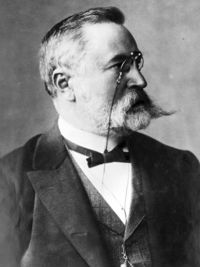
Johannes Schmidt (1850–1894)
Johannes Schmidt was professor of classical philology at the University of Giessen from 1883. He contributed numerous articles on Roman North Africa to the Realencyclopädie der classischen Altertumswissenschaft. As an assistant to Mommsen, he prepared the supplements 1, 2, and 3 to CIL VIII.
Further information.
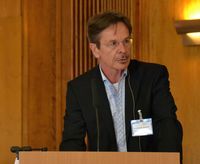
Manfred G. Schmidt (*1952)
Manfred Schmidt was managing director of the CIL Research Centre in Berlin between 1995 and 2017. He wrote an introduction to Latin epigraphy (2005; 2nd ed., 2011) and edited CIL XVII/1,1 together with Camilla Campedelli.
Further information.

Richard Schöne (1840–1922)
Richard Schöne was extraordinary professor at the University of Halle, advisor in the Prussian Ministry of Education and Cultural Affairs and, between 1880 and 1905, director of the Berlin Royal Museums. He contributed largely to the edition of the inscriptions from the Vesuvian cities (CIL IV).
Further information.

Heikki Solin (*1938)
Heikki Solin was director of the Institutum Romanum Finlandiae between 1976 and 1979 and professor of Latin studies at the University of Helsinki from 1985. He published several studies on antique onomastics, such as “Die griechischen Personennamen in Rom [Greek personal names in Rome]” (2nd ed. 2003) in the Auctarium to the CIL. Alongside Antonio Varone und Peter Kruschwitz, he edited CIL IV Suppl. 4,2.
Further information.
Ernst Stein (1891–1945)
Ernst Stein taught as private lecturer and professor of Byzantine history and philology in Vienna, Berlin, Brussel, Washington, Leuven, and Genoa. He edited Emil Ritterling’s writings after the latter’s death and was responsible for CIL XIII 6.
Further information.
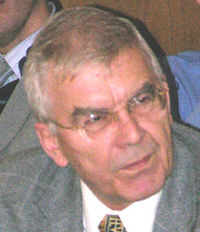
Armin U. Stylow (*1941)
Armin U. Stylow was a research assistant at the Commission for Ancient History and Epigraphy of the DAI, Munich. He edited CIL II2/5 und CIL II²/7.
Further information.
Johannes Szlatolawek
Johannes Szlatolawek compiled the indices to CIL XIII in collaboration with Hermann Dessau.
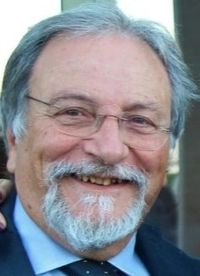
Antonio Varone (*1952)
Antonio Varone worked for the Soprintendenza Archeologica di Salerno-Avellino e Benevento before joining the Soprintendenza Archeologica di Pompei. He contributed to CIL IV Suppl. 4,1 and 4,2.
Further information.
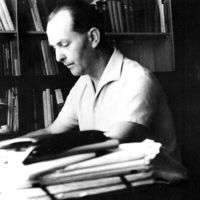
Ladislav Vidman (1924–1989)
Ladislav Vidman was classical philologist. He worked at the Czech Academy of Sciences in Prague from 1953, and, from 1962, at the Central Institute of Ancient History and Archaeology of the Academy of Sciences in the GDR. He compiled the Cognomina index to CIL VI.
Further information.
Hans Volkmann (1900–1975)
Hans Volkmann, alongside Ernst Stein, edited the tile stamps from Gaul and Germania in CIL XIII 6.
Further information.
Gerold Walser (1917–2000)
Gerold Walser taught ancient history at the Universities of Freiburg and Berlin. He contributed substantially to editing the milestones in CIL XVII/2, CIL XVII/4,1, and CIL XVII/4,2.
Further information.
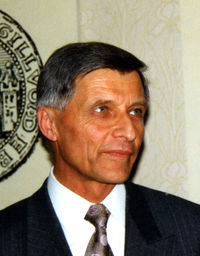
Volker Weber (*1936)
Volker Weber was a research assistant at the CIL in Berlin and was amongst the editors of CIL IV Suppl. 4,1.
Lothar Wickert (1900–1989)
Lothar Wickert was a research assistant at the CIL from 1924. Later, he became professor of ancient history in Königsberg and Cologne. He published CIL XIV Suppl. 1 and 2.
Further information.
Gustav Wilmanns (1845–1878)
Gustav Wilmanns was professor at the University of Strasbourg from 1872. On his research trips to North Africa, he collected over 11,000 inscriptions and thus laid the groundwork for the edition of CIL VIII.
Further information.
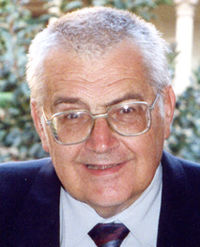
Gerhard Winkler (1935–2012)
Gerhard Winkler was secondary school teacher and the director of the secondary school in Perg. He edited the milestones from Noricum for CIL XVII/4,1.
Further information.
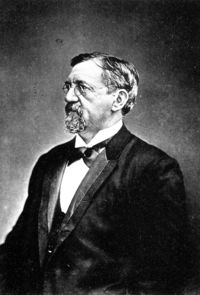
Karl Zangemeister (1837–1902)
Karl Zangemeister had worked at Heidelberg University Library since 1868, where he was appointed honorary professor of epigraphy in 1891. In his capacity as a research associate at the CIL, he spent several years in Italy. In collaboration with Richard Schöne, Zangemeister edited the inscriptions from the Vesuvian cities as well as Pompeian wax tablets in CIL IV. He then focused on inscriptions from upper Germania (CIL XIII 2,1).
Further information.
